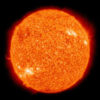There are many solar deities, but they all share things in common. Both giving and punishing, both warm and potentially damning. Does this seem to refute our contemporary understanding of the sun? But in the ancient world, the power of the sun was considered a living power. They didn’t have this concept of living and unliving. An interesting point, but given the biological concept of “living” we can’t say the sun isn’t. It is capable of consumption and conversion of matter. It can grow and decay, and can even potentially reproduce.
There were many associations among desert dwelling people, including the Israelis, that fire, the barren desert and that whole mess, were the abode of demons, of spirits inimical to man. Much like the Native American practice of vision questing, they believed that you would encounter those spirits there. This was why people saw mirages, or died sometimes even when carrying water and proper food supplies. So the role the sun was seen to have varied from culture to culture. For those native to the Italian peninsula, the sun was not so harsh as to kill. For the natives of Japan, it was so important as to be seen as sovereign. Having trouble growing things on their island, it seemed very benign. Even though most are Buddhist or Christian, they value the old symbolism and lore of their culture.
Is that why the Japanese flag bares a sun? Land of the rising sun isn’t it? That is what they call it, and it was what they felt made the Japanese islands rise. Scientific evidence does show a link between solar activity and geothermal activity, so maybe not so far fetched. In India, Japan, and Egypt the creation mythology amounts to the Sun God moving over the water and causing land to rise and life to be born in one way or another.
It may have been a way to understand the mystery of how sunlight seems to reveal the land, and the cycle of the sun rising and setting has been of much concern in general. Part of their understanding of why the sun burns is that it has to have the power to fight like humans do. So though it incidentally seemed to hurt humans, it was thought that it had more serious threats to its well being.
In many Asian beliefs, it was a serpent or dragon figure as it was in Egypt with the primordial God Apep who was seen as desiring to consume the sun, but likewise the sun has had serpent associations. The story of the corruption of Adam and Eve may have taken the serpent as the symbol of the first “invader” of what they considered their tribal lands, which as described in the Bible would include all of Mesopotamia which at one point was apparently quite fertile and rich. A land “of milk and honey”. Early Christians saw themselves in the same spirit as the “lost” Nation of Israel, and saw the sun worshipping Native American as marked for the unholy thing they did. As lesser than those who had “fear of God”.
What would they make of the suns ability to burn the skin? The sun they saw as a tribal chief type figure, and feudalism and the supposed “divine right of kings” arose from that understanding of social roles. A chief arose from having physical might and a fierce spirit, and would often lash out at other tribesmen. They saw the suns ability to burn (which was much less then than it is now) as that. The sun was a fitful God. Even in Greece, Apollo was seen as fickle and even to a degree as narcissistic. This is where we even get the word.
How is the moon related in sun worship? Universally, and following the same early intuition, they saw the sun and moon as siblings. Their exact genders were not universal. The moon was often seen as feminine, but not universally so. The moon was seen as very mysterious. It didn’t cause the crops or most animals to stir, but some animals did and seemed to have powers to function in the world that seemed very mysterious.
One of the early and most sacred Kami in Japan was a moon goddess, but the moon was associated with the underworld while the sun was considered the ruler of the heavens from which rain comes. The underworld wasn’t originally hell. It was the mysterious caves and burrows, the deep parts of the world from which men didn’t see very well, and yet still had life and seemed to be favoured by predatory things, like bears, or strange unnatural things like bats. These would stir when the moon was in the sky, so they were seen as the children of the moon god/goddess.
Bats are wonderful things. They certainly are. They make a sharp bite in the possible pestilence we would face without them, like vultures eating carrion, but they were associated with death and the underworld. They weren’t at war. Disney did a disservice in making Hercules. Hades was never Zeus’s enemy, nor was he murderous. He was mysterious and scary because he was Lord of Death and the underworld. But he was Zeus’s equal and respected his brother. They were brothers, both born of Chronos and Gaea.
Your thoughts are welcome. Be well friends.
Travis Saunders
Dragon Intuitive
~science,mysticism,spirituality~



Leave a Reply